This comprehensive Conservation of Plants and Animals notes will serve as a guide, unraveling the complexities of conservation and shedding light on the challenges faced by our natural world. Through these notes, you will delve into the significance of biodiversity, the interdependence of plants and animals, and the delicate web of life that connects every living organism.
You will explore the causes and consequences of human activities that threaten the existence of numerous species. From habitat destruction to pollution, we will examine the impact of these actions on the fragile ecosystems that support life. Furthermore, we will delve into the principles and practices of conservation that can help mitigate these threats and preserve our planet’s precious biodiversity.
These notes are helpful for class 8 students and most useful at exam times when you’d want to summarize the important points quickly.
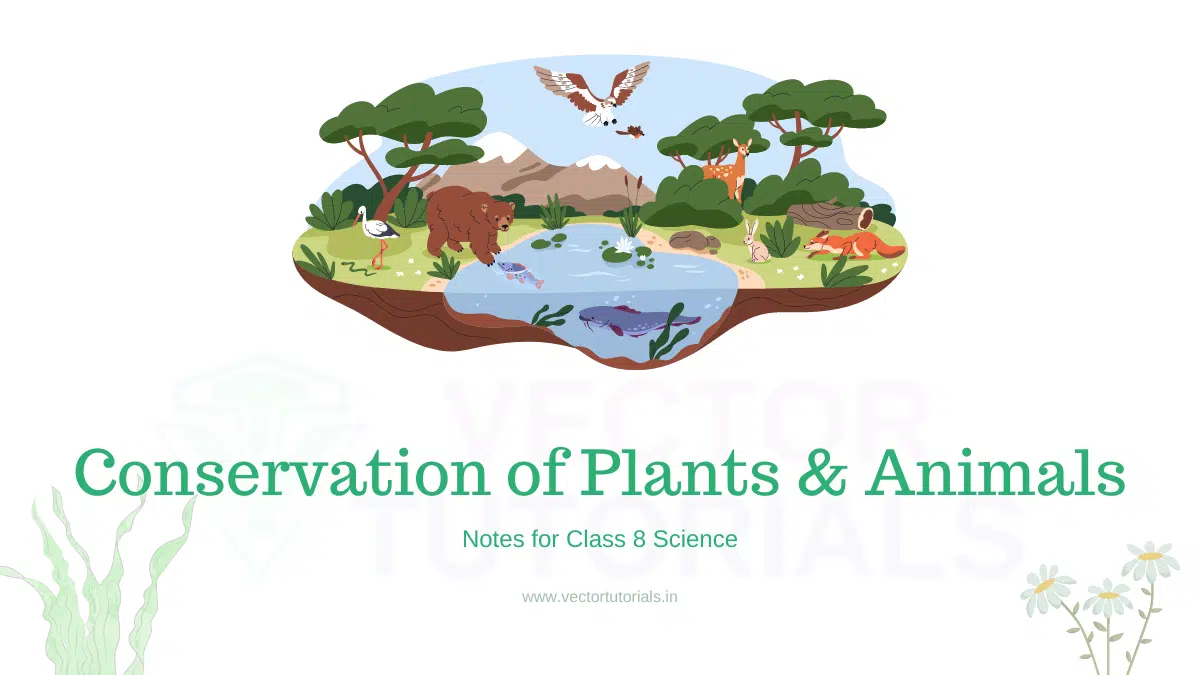
Conservation of Plants and Animals Notes
Welcome to the world of conservation of plants and animals, where we embark on a journey to safeguard the magnificent treasures of our planet. In the vast tapestry of life, plants and animals form the very essence of our existence. They bring beauty to our landscapes, provide us with sustenance, and contribute to the delicate balance of ecosystems that support all life on Earth.
Recognizing the vital role played by plants and animals, it becomes imperative for us, as stewards of this planet, to understand and actively engage in the conservation of plants and animals.
Biosphere
The biosphere is the zone of the Earth where life exists. It encompasses all living organisms, their habitats, and their interactions. The biosphere extends from the deepest ocean depths to the highest mountain peaks, from the driest deserts to lush rainforests, and from the coldest Arctic regions to the hottest tropical zones.
- The biosphere plays a crucial role in maintaining the conditions necessary for life to thrive. It regulates the Earth’s climate, cycles nutrients, purifies water and air, and provides habitats for countless species.
- It is a vast network of interconnected ecosystems where organisms depend on one another for survival and contribute to the overall functioning of the biosphere.
- One of the remarkable features of the biosphere is its resilience and ability to adapt to changing conditions.
- The biosphere plays a crucial role in maintaining the conditions necessary for life to thrive. It regulates the Earth’s climate, cycles nutrients, purifies water and air, and provides habitats for countless species. It is a vast network of interconnected ecosystems where organisms depend on one another for survival and contribute to the overall functioning of the biosphere.
- One of the remarkable features of the biosphere is its resilience and ability to adapt to changing conditions. Organisms have evolved and diversified over millions of years, adapting to various environments and forming intricate ecological relationships.
- The biosphere helps in the conservation of wildlife of the area and maintains the biodiversity of the area.
- It also prevents the commercial exploitation of wildlife and provides opportunities for scientific research, environmental education, and tourism.
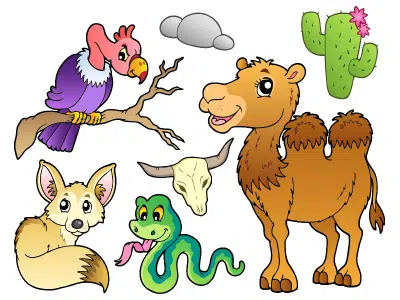
Biodiversity (Biological Diversity)
Biodiversity, short for biological diversity, refers to the variety of life forms found on Earth. It encompasses the incredible array of species, genes, and ecosystems that exist within the biosphere. Biodiversity is a measure of the richness and complexity of life, representing the culmination of millions of years of evolutionary processes.
- The term biodiversity was coined by Walter G. Rosen in 1896.
- Biodiversity is important for the survival of all living beings.
- Biodiversity exists at multiple levels. At the species level, it refers to the variety of different organisms, ranging from microorganisms to plants, animals, and humans. Each species has its unique set of characteristics, behaviors, and adaptations that contribute to the overall diversity of life.
- It is very important to conserve the vast biodiversity which exists on this planet because it helps us in many ways, such as pollination, nutrient cycling, and regulation of the atmosphere and climate.
Causes for Decline in Biodiversity
- Increasing human population
- Overexploitation of plant and animal species
- Deforestation and Habitat destruction
- Environmental pollution
- Global warming
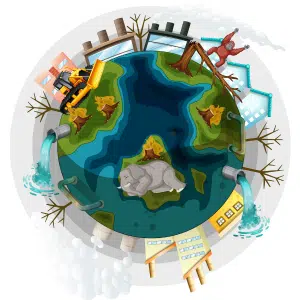
Harmful Effects of the Decline in Biodiversity
- Potential collapse of ecosystems.
- Ecological disruption
- Decreased resilience to environmental changes.
- Loss of medicinal resources
- Impacts on food security
Conservation of Biodiversity
Biodiversity (conservation of plants and animals) is possible by reforestation, preserving wildlife, and establishing wildlife sanctuaries, national parks, and biosphere reserves.
Sanctuary
Areas, where animals are protected from any disturbance are called a sanctuary. It is a protected area created by the government. The government lays down rules, methods, and policies to protect and conserve animals.
- Wildlife sanctuaries are mainly established to protect endangered species. They may also be established to preserve biodiversity.
- Threatened wild animals such as black buck, white-eyed buck, golden cats, marsh crocodiles, pythons, and rhinoceros are protected in the wildlife sanctuaries of India.
- There are around 441 wildlife sanctuaries in India. Some of them are provided below:
| Sanctuary | State |
|---|---|
| Sanjay Gandhi Wildlife Sanctuary | Maharashtra |
| Mudumalai Wildlife Sanctuary | Tamil Nadu |
| Nagarjunsagar Wildlife Sanctuary | Andhra Pradesh |
| Sultanpur Lake Sanctuary | Haryana |
| Bharatpur Bird Sanctuary | Rajasthan |
| Thattekad Bird Sanctuary | Kerala |
| Bori Wildlife Sanctuary | Madhya Pradesh |
| Lockchao Wildlife Sanctuary | Manipur |
| Satkosia Basipalli Wildlife Sanctuary | West Bengal |
| Dandeli Wildlife Sanctuary | Karnataka |
Please note the sanctuaries are different than the zoos. Here are some differences between both:
| Wildlife Sanctuary | Zoo |
|---|---|
| 1. The wild animals and birds live in their natural habitat in the forest. | 1. Wild animals and birds live in artificial habitats such as cages and enclosures. |
| 2. It is not open to the public freely. They can only visit when accompanied by a forest guard. | 2. It is open to the public for a fixed time every day. |
| 3. It contains wild animals and birds found locally. | 3. It contains wild animals and birds brought from different parts of the country and from other countries. |
| 4. Wild animals and birds are very comfortable in the natural environment of a wildlife sanctuary | 4. Wild animals and birds are not comfortable in the artificial environment of a zoo. |
National Park
Areas reserved for wildlife to freely use the habitat and natural resources are called national parks. Some national parks are home to a particular animal species. Examples: Gir National Park in Gujarat for Asiatic lions, Kaziranga National Park for rhinoceros, Kanha National Park for tigers, etc. There are almost 96 national parks in India.
Some advantages of national parks are:
- National parks preserve wildlife as well as the important environmental heritage of a nation.
- They provide evidence of prehistoric human life in the jungles.
- The national park provides human recreation and enjoyment and also protects the whole sets of ecosystem.
Some of the national parks in India are:
| National Park | State |
|---|---|
| 1. Corbett National Park | Uttarakhand |
| 2. Kanha National Park | Madhya Pradesh |
| 3. Ranthambore National Park | Rajasthan |
| 4. Gir National Park | Gujarat |
| 5. Kaziranga National Park | Assam |
| 6. Sunderbans National Park | West Bengal |
| 7. Bandipur National Park | Karnataka |
| 8. Dachigam National Park | Jammu and Kashmir |
| 9. Sariska National Park | Rajasthan |
| 10. Satpura National Park | Madhya Pradesh |
Project Tiger: Project Tiger was launched by the Indian Government in 1973. The main motive of this project was to protect tigers by providing them a safe place to flourish. Hence, special tiger reserves such as the Satpura Tiger Reserve and the Sariska Tiger Reserve were constructed throughout the country.
Biosphere Reserves
Large areas of protected land for conservation of biodiversity. This includes plant animal resources, traditional tribal living, wildlife, etc. E.g., Pachmarhi Biosphere Reserve.
Here is a list of some biosphere reserves in India:
| Biosphere Reserve | State |
|---|---|
| 1. Great Nicobar Biosphere Reserve | Andaman and Nicobar Islands |
| 2. Kaziranga Biosphere Reserve | Assam |
| 3. Kanha Biosphere Reserve | Madhya Pradesh |
| 4. Sunderbans Biosphere Reserve | West Bengal |
| 5. Pachmarhi Biosphere Reserve | Madhya Pradesh |
Deforestation
Clearing forests and using that land for other purposes such as cultivation, building houses and factories, making furniture, and using wood as fuel is called deforestation. It is done due to the following causes:
- Urban and construction purposes
- To obtain fuel
- To grow crops
- To create grazing lands
- Forest fires, droughts, and volcanic eruptions can also cause deforestation.
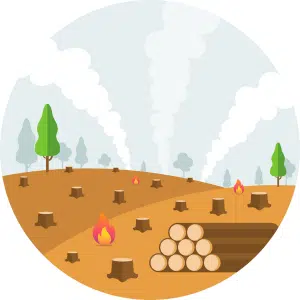
Whether it is done for development purposes or happens naturally, deforestation comes with several consequences to our surroundings and the entire Earth. Here are some consequences of deforestation:
- It increases the temperature and adds pollution level on earth.
- Increment of carbon dioxide in the atmosphere.
- The groundwater level is lowered.
- There will be a disturbance in the balance of nature, such as alteration of local and global climate.
- Deforestation also decreases the fertility of the soil.
- It increases the chances of natural calamities such as floods and droughts.
- No forests mean no wildlife (wild plants and animals) or forest products.
Desertification
Desertification is the removal of the top layer of the soil due to soil erosion, exposing rocky, hard soil with less humus. Such soil is less fertile and soon converted into a desert. Desertification also decreases the water-holding capacity of the soil. Thus, there are floods. Desertification can be caused by deforestation too.
Conservation of forests
As discussed earlier, forests are cleared for agriculture, forestry, housing, and other developmental activities, such as the construction of roads and the building of hydroelectric plants. Protection of forest cover is the need of the hour.
- Reforestation is restocking destroyed forests by planting new trees.
- It takes place on land where trees are recently removed either due to harvesting or due to a natural disaster such as a fire, flood, or volcanic eruption.
- Reforestation can occur naturally or through human efforts.
- If a deforested area is left undisturbed, then it can re-establish and mature itself naturally. However, planting trees can reduce the length of time required for a forest to mature.
Conservation of Wildlife
Preservation of forests and wildlife is a big challenge placed before us. Many wild species are either extinct or endangered. It is, therefore, essential to conserve the rich wildlife and prevent its extinction. Numerous forests, fisheries, and wildlife resources are overexploited because of their economic value.
Overexploitation reduces the number of certain species of plants and animals while others become rare or endangered and sometimes even extinct.
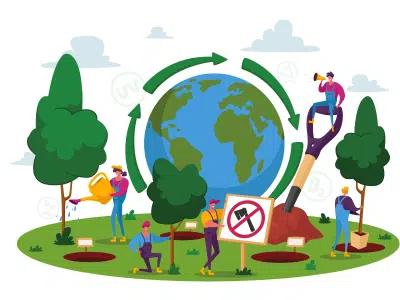
Here are some ways to conservation of plants and animals in wildlife:
- Conserving a habitat: Conservation of habitat refers to taking care of the habitat of wild animals so that they feel safe and secure. Hence, we need to secure the existing habitats.
- Creating a habitat: Protection of endangered species by creating protected areas such as national parks, sanctuaries, and biosphere reserves.
- Protection by Law: The Indian Government has implemented strict laws to protect wildlife. According to the Wildlife Protection Act 1972, poaching or killing of animals is punishable by law.
- Organizations involved in wildlife conservation of plants and animals:
- The International Union for Conservation of Nature (IUCN) provides information about endangered plant and animal species.
- In India, the Indian Board for Wildlife plays an important role in monitoring endangered species.
- The World Wide Fund for Nature (WWF) also plays an active role in conserving natural resources.
Flora and Fauna
Plants and animals found in a particular area are termed as Flora and Fauna of that area. E.g., Sal, teak, mango, and jamun are flora, while chinkara, barking deer, chital, and the blue bull are Pachmarhi Biosphere Reserve’s fauna.
Species
A species is an organism of a particular kind whose members can interbreed to produce fertile young ones. Members of a species have common characteristics. All human beings belong to the same species, Homosapiens.
The species are divided into further types:
| Species | Description |
|---|---|
| Rare Species | Rare species exist in relatively low numbers but are not necessarily in immediate danger of extinction – examples: Black and white ruffed lemur, Aloe polyphylla, etc. |
| Endangered Species | An endangered species is one in which the population of organisms is at risk of extinction – examples: The Indian rhinoceros, the Great Indian bustard, Pink Butterfly Orchid, etc. |
| Vulnerable Species | Species that exist in low numbers and may become endangered due to the destruction of their habitat, overexploitation, or some other environmental factor are called vulnerable species – examples: The Asian elephant, Rafflesia, etc. |
| Threatened Species | Threatened species are any species which are vulnerable to endangerment in the near future – examples: Giant Panda and Monarch butterfly. |
| Endemic Species | Plant and animal species that are found only in a particular region and nowhere else in the world are called endemic species – examples: Nilgiri leaf monkeys found in the Nilgiri Hills of the Western Ghats; Asiatic lions of Gir National Park, Gujarat; Bengal tiger found in Sundarbans National Park, West Bengal. |
| Extinct Species | A species is considered extinct when no member of the species is still alive -examples: Dodo, Woolly Mammoth. |
Red Data Book: The Red Data Book keeps a record of all the endangered animals and plants. Different red data books are maintained for plants, animals, and other species.
Migration
The movement of animals in large numbers from one place to another to overcome unfavorable conditions is called migration. Migratory birds migrate due to changes in climatic conditions.
- Due to extreme cold, their natural habitat becomes unsuitable for the incubation of eggs, and hence, they migrate to a location of suitable climate.
- Siberian cranes migrate to Bharatpur in Rajasthan because the environmental conditions there are more favorable than in Siberia, where they come from.
Recycling of Paper
Paper recycling is the process of remaking new paper products from waste paper. Besides recycling, used sheets of paper can be used to make useful things such as paper bags, writing paper, greeting cards, and wrapping paper. Recycling paper helps to conserve energy as it uses 25% less energy than the energy used in making paper from trees.
A decline in biodiversity can have far-reaching and significant consequences for ecosystems, human societies, and the planet as a whole. It can cause ecological disruptions, reduce the ecosystem, affect food security, and there will be cultural losses. Hence, the conservation of plants and animals is necessary to keep the biosphere secure.
In this conservation of plants and animal notes, we have provided the basics of conservation that will allow the students to understand the importance of conservation of plants and animals. It is our duty to conserve nature so that the planet can stay alive for the next generations.
Conservation of plants and animals is possible by understanding the value of biodiversity, implementing conservation measures, and adopting sustainable practices, we can help mitigate the decline and preserve the vital services and benefits that biodiversity provides to our planet and future generations.
FAQs for Conservation of Plants And Animals
More science notes for class 8